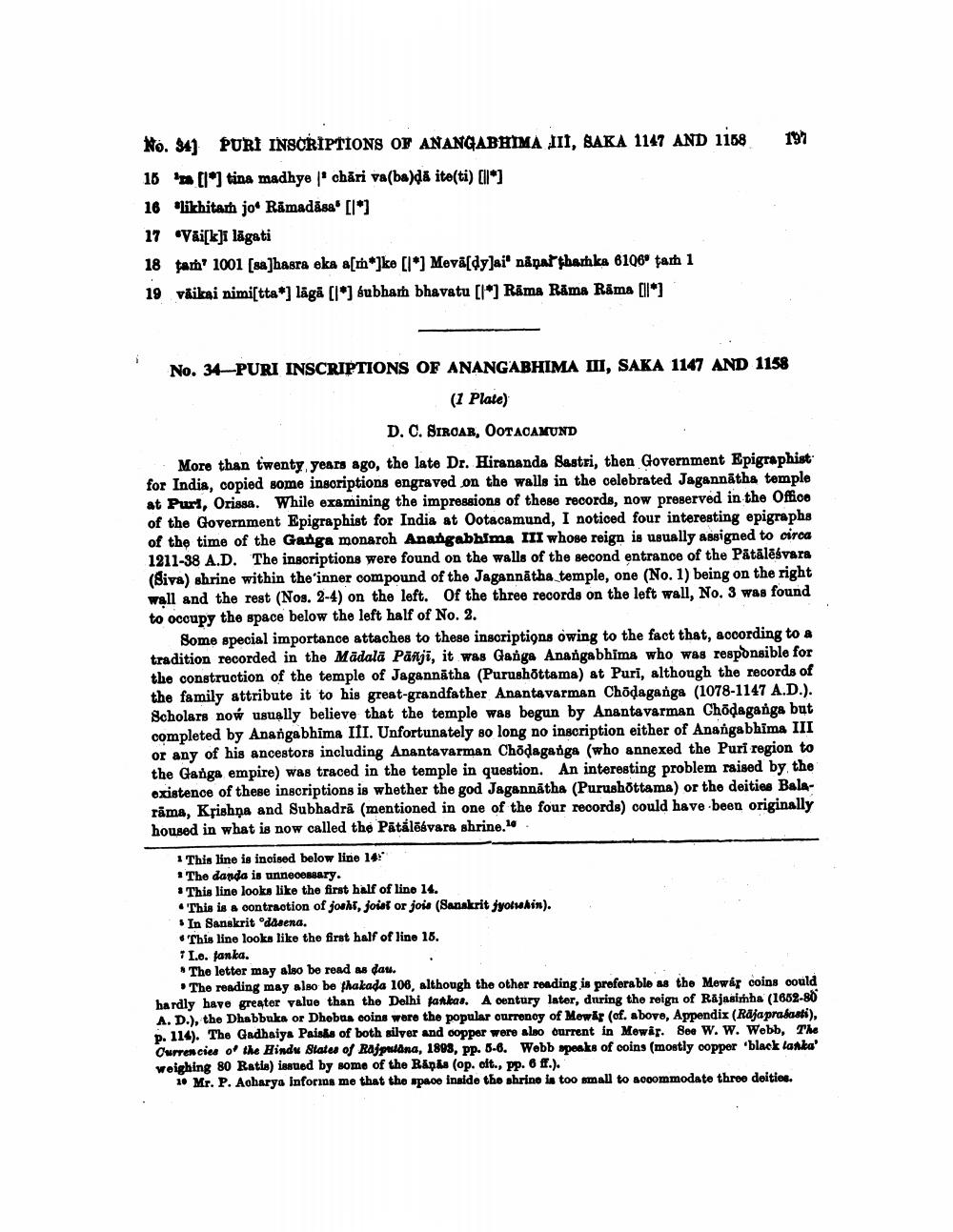________________
1997
No. 34) PURI INSCRIPTIONS OF ANANGABHIMA LII, BAKA 1147 AND 1168 16 pa llotina madhye | châri va(ba)da ite(ti) [ll] 16 "ikhitam joRamadāsa [l*] 17 "Vai[k]i lagati 18 tah? 1001 [sa]hasra eka a[**]ke [l*) Mevä[dylai' napattharka 6106" tanh 1 19 vaikai nimistta*) lāgā [l*) bubham bhavatu [l*) Rāma Rama Rama (1)
No. 34-PURI INSCRIPTIONS OF ANANGABHIMA MI, SAKA 1147 AND 1158
(1 Plate) D. C. SIROAR, OOTACAMUND
More than twenty years ago, the late Dr. Hirananda Sastri, then Government Epigraphist for India, copied some insoriptions engraved on the walls in the celebrated Jagannatha temple at Purl, Orissa. While examining the impressions of these records, now preserved in the Office of the Government Epigraphist for India at Ootacamund, I noticed four interesting epigraphs of the time of the Ganga monarch Anangabhima III whose reign is usually assigned to circa 1211-38 A.D. The insoriptions were found on the walls of the second entrance of the Pätālēsvara (Siva) shrine within the inner compound of the Jagannātha temple, one (No. 1) being on the right wall and the rest (Nos. 2-4) on the left. Of the three records on the left wall, No. 3 was found to occupy the space below the left half of No. 2.
Some special importance attaches to these inscriptions owing to the fact that, according to a tradition recorded in the Mädala Panji, it was Ganga Anangabhima who was responsible for the construction of the temple of Jagannātha (Purushottama) at Puri, although the records of the family attribute it to his great-grandfather Anantavarman Chodaganga (1078-1147 A.D.). Scholars now usually believe that the temple was begun by Anantavarman Chodaganga but completed by Anangabhima III. Unfortunately so long no inscription either of Anangabhima III or any of his ancestors including Anantavarman Chodaganga (who annexed the Puri region to the Ganga empire) was traced in the temple in question. An interesting problem raised by the existence of these inscriptions is whether the god Jagannātha (Purushottama) or the deities Balarima. Krishna and Subhadra (mentioned in one of the four records) could have been originally housed in what is now called the Patálokvara shrine.
1 This line is incised below line 14% * The danda is unnecessary. * This line looks like the first half of lino 14. • This is a contraction of josht, joiss or joia (Sanskrit jyotuhin). $ In Sanskrit dasena. • This line looks like the first half of line 18. 11.e. fanka. • The letter may also be read as dau.
The reading may also be thakada 106, although the other reading is proforable as the Mewar coins could hardly have greater value than the Delhi fankas. A century later, during the reign of Rajasimha (1662-80 A. D.), the Dhabbuka or Dhobus coins were the popular currenoy of Mewar (of. above, Appendix (Rajapradosti), p. 114). The Gadhaiya Paisls of both silver and copper were also current in Mewar. See W. W. Webb, The Ourrencies of the Hindu Status of Rajpaidna, 1893, pp. 5-6. Webb speaks of coins (mostly oopper 'black lanka' weighing 80 Ratis) issued by some of the Rapis (op. cit., pp. 6 ff.).
1. Mr. P. Acharya inforios me that the space inside the shrine is too small to accommodate three deities.




